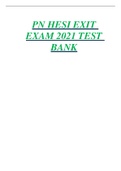Overig
Exam preparation
- Vak
- Instelling
Notes to go through in order to prepare for your examination. Consists of questions with answers taken from various previous assignments, question papers, online revision, and study guide activities.
[Meer zien]









